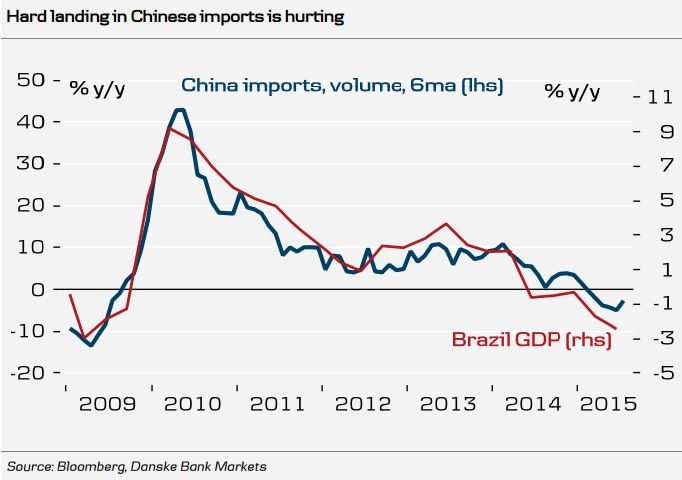There is a lot of focus on the risk of a Chinese hard landing at the moment and whether China can avoid such a scenario. While China may not experience a hard landing in terms of the overall growth rate collapsing, China's manufacturing sector is very close to what could be characterised as a hard landing. The average growth rate in Chinese industrial production over the period 2000-2012 was 13.5% y/y but has fallen to around 6% y/y over the past quarter - a very sharp move lower. In addition, import growth in volumes is in negative territory, falling by 1% y/y in the past few months. This compares with an average growth in imports over the period 2005-2012 of 8.9%. An economy like Brazil has a very high exposure to China and Brazil GDP is highly correlated with Chinese import growth, as shown in the chart below.
If China is growing close to 7%, it seems clear that it is growth increasingly driven by the service sector with much less import content. It also explains why there is no sense of urgency from the Chinese government. The National Development and Reform Commission has announced that China created 9.5 million new jobs in the first eight months of the year despite the lower growth rate, which was 95% of the target for the whole year. Hence, what seems to be a very hard Chinese landing for the rest of the world is still a fairly soft landing for China itself.
The rapid rebalancing in recent years is also evident from the industry and service sectors' share of the overall economy. The industrial and construction sector is now 42% of the overall economy, whereas the service sector is 49%. This development is welcomed by the Chinese leadership. Premier Li Keqiang said in a speech on 10 September that "What is more encouraging is that China's economic structure is rapidly improving". Hence, we should not expect industrial production to rise much from current growth rates but activity will instead be generated more in the service sector. This is positive for China - but has big implications for countries with export exposure to the manufacturing and construction led growth in the past, which created a huge demand for commodities. Hence, commodity exporters are unlikely to see much relief in coming years and a country like Brazil needs to recalibrate its whole economy, which will likely be a long and painful process.
According to Danske Bank, Chinese growth is expected to be weak in the short term, as also signalled by a further decline in Flash PMI manufacturing for September but during the next two-three months we look for stimulus and a housing recovery to kick in and lead to a moderate rise in growth from 6% q/q annualised to 6.5% q/q annualised in Q4 and a similar pace next year. However, the composition of growth will continue to be increasingly service sector driven and as such not give a big boost to the rest of the world through higher import growth.
Chinese rebalancing feels like a hard landing for the world

Saturday, September 26, 2015 7:56 AM UTC
Editor's Picks
- Market Data
Most Popular


































